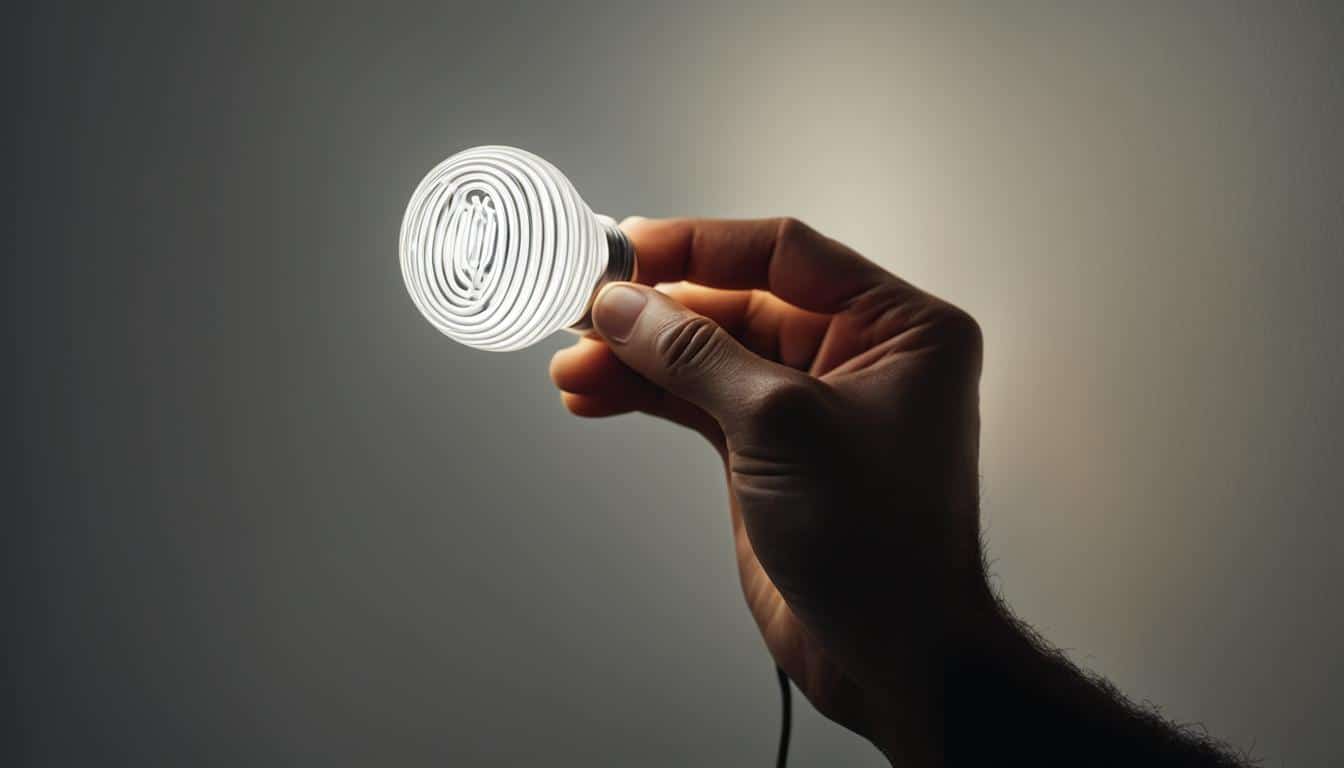We’ve all been there, standing in the comfort of our homes when suddenly, a led light bulb flickering when turned on shatters the room’s tranquility. It’s a common nuisance that many of us face – a flickering LED light bulb presenting an irritating strobe effect that disrupts the harmony of our living spaces. As experts in everyday home maintenance, we aim to shed light on why your LED bulbs may start to flicker, particularly on startup, and how you can fix this electronic quirk to restore calm to your rooms.
The dreaded flickering led light bulb isn’t just an annoyance – it’s a sign that something in our lighting system isn’t quite right. Unlike the straightforward fixes attributed to older incandescent or fluorescent bulbs, LED bulb flickering can indicate a variety of underlying issues. These problems can range from minor annoyances to more concerning electrical issues, all of which we are here to help you understand and resolve. By the end of this guide, a flickering light bulb upon startup will be a headache of the past.
Key Takeaways
- Identifying the causes of LED light bulb flickering, especially upon startup, is the first step towards a solution.
- Low-frequency oscillations and incompatible dimmer switches are common culprits behind a flickering LED light bulb.
- Flickering can stem from electrical issues, such as faulty drivers, which may necessitate a more technical approach.
- Diagnosing the exact cause of flickering is essential in choosing the right method to fix the issue effectively.
- Investing in quality LED bulbs with appropriate drivers helps prevent flickering, ensuring a more stable lighting environment.
- Understanding the role of dimmer switches and electrical wiring helps to maintain a flicker-free home lighting system.
Understanding LED Light Bulb Flickering
When we encounter a flickering LED bulb, it’s not just a source of irritation; it can also detract from the ambiance of a space and can even affect our well-being. As experts in lighting solutions, we know that understanding the nuances of led light bulb flickering is the first step in solving this common, yet perplexing issue. To shed some light on this subject, we’ll explore several factors that can cause that unwelcome strobe effect in LED lighting.
Common Causes of Flickering in LED Lights
Flickering in LED lights can be a symptom of various underlying issues. It’s often a sign that the bulb isn’t functioning at its optimal capacity. Loose connections, either at the switch or the bulb itself, are frequent culprits. Furthermore, compatibility is key; dimmer switches not expressly designed for LEDs can be problematic and lead to noticeable led bulb flickering. Sometimes, the issue is internal, and we may find that a subpar LED driver—the component that regulates power to the light—can make lights prone to flickering.
Impact of Low-Frequency Issues on LED Performance
Low-frequency oscillations, under 50 Hz, can cause visible light flickering. This is particularly evident when we have fluctuations in our home’s electrical supply, which can be exacerbated by using high-powered appliances on the same circuit as our LED bulbs. These fluctuations can overwhelm LED drivers, especially those not built to withstand such electrical variances, resulting in a degradation of the light’s performance and led flickering.
Distinguishing Between Different Types of Flicker
Not all flicker is equal. There’s high-frequency flicker, which tends to be invisible to the naked eye but can still have adverse effects, like eye strain over prolonged exposure. Then there’s the low-frequency flicker, which is far more noticeable and can be quite distracting. Identifying the type of flicker is crucial, as it helps us target the right solution—be it upgrading our bulbs, revising our electrical layout, or choosing the right dimmer switch to ensure a consistent, stable performance of our LED lights.
We’re committed to helping you achieve optimal lighting in your home with minimal led light bulb flickering. Stick with us, and let’s illuminate the path to steady, reliable LED illumination together.
Diagnosing the Flicker in Your LED Lights
When we encounter a flickering bulb, we know the annoyance it can bring to any setting. Irregular lighting not only affects the ambiance but can also strain the eyes. If you’ve noticed your light bulb flickering, it’s time to play detective to uncover the cause of this electrical enigma. A crucial step in remedying a flickering LED light involves a close inspection to identify any potential loose connections. Often, these connections are the primary suspects in the case of a flickering LED.
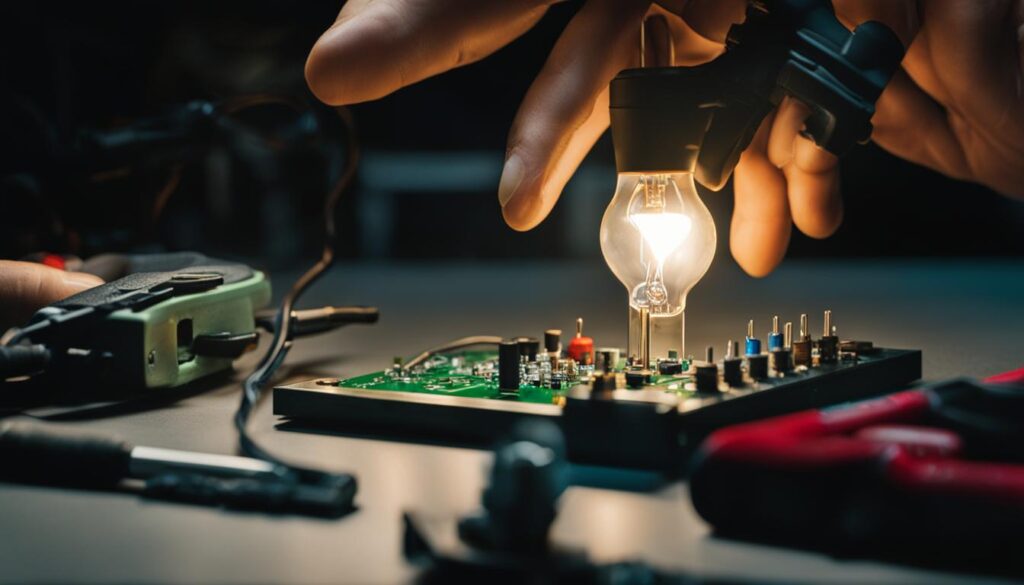
Pinpointing the problem may seem daunting, but by examining your home’s wiring, verifying all contacts at the bulb’s insertion point, and checking for correct fixture installation, you’ll get one step closer to a flicker-free home. These examinations can shed some light on why your bulbs might be misbehaving. Moreover, a holistic approach towards diagnosing includes understanding how voltage fluctuations and other power-hungry appliances may influence your lighting system. By addressing these factors, you can help establish an evenly lit environment.
- Inspect Light Fixtures: Ensure that all components are intact and firmly in place.
- Examine Home Wiring: Look for signs of wear and tear, which could be causing electrical inconsistencies.
- Check Bulb Insertion: Loose bulbs can lead to intermittent connections and flickering.
- Voltage Variation: Observe if voltage changes when other appliances are in use.
- Power Draw from Other Devices: Note the behavior of your lights when high-power devices are turned on.
After taking these steps, if the problem persists, use the following table to help decide your next course of action:
| Inspection Area | Issue Check | Immediate Action |
|---|---|---|
| Light Fixture | Loose Parts | Tighten or replace components |
| Wiring | Worn or exposed wiring | Consult a professional electrician |
| Bulb Socket | Improper Fit | Ensure bulb is correctly installed |
| Home Voltage | Fluctuations | Use a voltage tester/monitor |
| Other Appliances | High Power Consumption | Consider circuit upgrades or dedicated lines |
Remember, a methodical approach will lead us to the root of the issue more efficiently than random attempts at a solution. With our steps and tables guiding your path, finding the cause behind that flickering bulb or light bulb flickering can be an approachable, constructive task. Let’s ensure our lights do their job and brighten our spaces without the flicker!
Initial Troubleshooting Steps
When we encounter the issue of a flickering LED light bulb, our initial action is straightforward: we examine the bulb itself. It’s critical to start with the basics to fix led light bulb flickering. A bulb incorrectly installed or not seated firmly can lead to intermittent connections and cause flickering. Let’s get hands-on and ensure the bulb is properly fixed to its socket.
Checking the Bulb Installation
Our journey to resolve flickering led bulb problems begins with the bulb’s installation. Simple though it may seem, a loose bulb is often at the heart of the flickering dilemma. Make certain that the LED light bulb is screwed into its socket snugly and securely. This not only assures a solid electrical connection but also prevents any unnecessary fluctuations in the bulb’s performance.
Inspecting for Loose Wiring and Connections
After the bulb has been checked, we direct our attention to the fixture itself – are there any loose wires? Such issues are common and can significantly disrupt the electrical flow, leading to a flicker. During our inspection, every connection is scrutinized, with a focus on areas that are susceptible to wear and tear. Our goal is to identify potential weak points in the circuit that could be contributing to the flickering issue.
As we continue our troubleshooting, we consider the compatibility of the bulb with existing dimmer switches. A mismatch between newer LED technology and older dimmer models tailored for high-wattage bulbs can create an unstable current that results in flickering. Replacing outdated dimming switches with modern alternatives designed for LEDs often proves to be an effective solution.
Our pursuit to fix led light bulb flickering is methodical. Step by step, we address the most accessible potential causes first, ensuring that each solution is executed with care. Our aim is not merely to provide a temporary fix but to ensure lasting, flicker-free illumination.
LED Light Bulb Flickering When Turned On
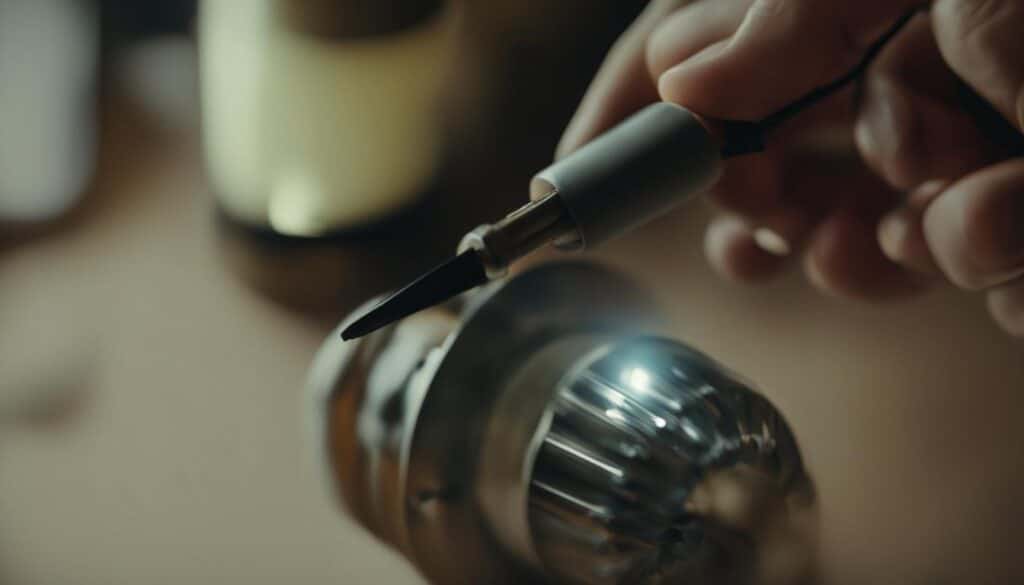
When we flip the switch and observe an LED light bulb flickering when turned on, it’s an indicator that we should engage in some LED light troubleshooting. This common issue can often be resolved with a few simple steps. First, let’s address the installation of the bulb itself, ensuring that it’s secure in its socket with no wiggle room for electrical misconnections.
- Inspect the light socket for signs of wear or corrosion.
- Check if the bulb is screwed in tightly, as a loose bulb can cause flickering.
- Test the light switch and its wiring, as faults here can impact power delivery.
Next, it’s time to evaluate our power outlets. Over time, the contact blades within a socket can deteriorate. Faulty outlets can not only cause flickering but also pose a safety risk. Loose wiring connections are also culprits that need our attention. By tightening these connections, we may stop the flickering and improve the overall stability of the electrical system.
Remember, resolving the flicker isn’t just about aesthetics; it’s about ensuring a safer, more efficient home lighting system.
By methodically eliminating these common issues, we’re on our way to resolving the flickering LED light bulb on startup and enjoying a steadier light source. Remember, if preliminary fixes do not resolve the issue, it may be necessary to consult a professional electrician.
The Role of LED Drivers in Flickering Issues
The irritating issue of LED driver flickering is often more than just an annoyance—it’s a sign of an underlying problem in the lighting system. LED drivers play a pivotal role in ensuring consistent lighting and when they falter, our ambiance suffers. Let’s delve into how these drivers influence the stability of our LED lighting and learn when it’s time to address LED bulb driver issues or outright replace LED light drivers for optimal performance.
How Defective Drivers Can Cause Flickering
It’s often overlooked that the humble LED driver is the guardian against instability in our lighting systems. A defective or low-quality driver struggles to regulate current flow, resulting in a visible pulsation of light—or what we commonly refer to as flickering. These electrical glitches are noticeable interruptions in lighting that can range from a mild strobe effect to a rapid-fire sequence of light bursts. It is this lack of consistent current supply that often points to the need for a replacement.
When to Replace the LED Driver
Knowing when to replace a troublesome driver is key to maintaining seamless light quality. If you’re constantly grappling with flickers or a disrupted lighting operation, it may be time to bid farewell to the inferior driver and upgrade. A high-quality driver not only steadies the flow of power but also adapts to fluctuations, ensuring your LED lights shine evenly, without interruption.
It’s also worth mentioning that not all LED drivers are created equal. Some boast greater resistance to power variances and provide a buffer that prevents flickering. This level of quality, albeit at a higher initial cost, can spare you the headache of continual replacements and offer assurance of enduring, flicker-free illumination. When flickering becomes a thorn in your side, investing in a commendable LED driver is a bright decision for a luminous future.
Dimmers and LED Flickering
When it comes to home lighting, the blend of technology and functionality can sometimes lead to unexpected issues, such as incompatible dimmers led flickering. As we’ve discovered, many traditional dimmers operate by chopping the power supply, causing sharp on-off cycles that LED bulbs aren’t designed to handle. This mismatch is frequently at the core of led dimmer flicker issues, and understanding the specifics can help mitigate these frustrating occurrences.
Let’s illuminate the problem further. Below, you’ll find a detailed comparison of characteristics between compatible and incompatible dimmers when used with LED lighting:
| Compatible LED Dimmers | Incompatible LED Dimmers |
|---|---|
| Designed for low power consumption | Typically higher power output |
| Smooth dimming performance | May cause abrupt or choppy transitions |
| Extended LED lifespan | Potential for premature LED failure |
| Flicker-free experience | Visible flickering and light quality issues |
| Ensures consistent LED brightness | Fluctuating brightness levels |
With the right dimmer in place, we can effectively prevent LED flicker issues and prolong the life of our bulbs. Yet, retrofitting existing lighting systems with LED-compatible dimmers isn’t just a one-step solution but a valuable upgrade for energy efficiency and ambiance control throughout our spaces.
If you’re dealing with led dimmer flicker issues, the resolution might involve switching to an LED-rated dimmer. Not all dimmers specify LED compatibility, so it’s crucial to check the product details. Manufacturers such as Lutron and Philips offer a range of LED-friendly dimmers that are known to match well with LED bulbs, ensuring a harmonious and flicker-free environment. Moreover, remember always to read the specifications of both the LED bulbs and dimmers to ensure they align.
- Inspect your current dimmers for LED compatibility.
- Seek dimmers with smooth, continuous dimming capabilities.
- Prioritize products with clear specifications for LED use.
- Consider investing in reputable brands known for LED dimming solutions.
Embracing this knowledge is essential for us as we navigate through the complexities of modern lighting. Together, we can achieve that seamless dimming experience and bid farewell to the woes of incompatible dimmers led flickering.
The Influence of External Power Interference
When it comes to LED lighting, we often focus on the fixtures themselves, but we cannot overlook the environment they operate within. External power interference can play a major role in the undesirable effect known as power interference LED flicker. Such interference disrupts the consistent flow of electricity that LEDs require, leading to annoying and potentially harmful flickering.
Understanding Inrush Current from Other Devices
In a household bustling with electrical gadgets, large appliances can draw significant inrush current upon activation. This initial surge of power can temporarily affect the voltage across the home’s electrical circuitry. Our LED fixtures, sensitive to such fluctuations, may respond with a flicker. This phenomenon is a clear illustration of the inrush current effects on LEDs. Awareness is critical, as the cumulative impact of these power dips can lead to diminished LED performance over time.
Dealing with Overloaded Circuits
Similarly, an electrical circuit overload presents a risk not only to the longevity of LED lights but also to the safety of our electrical systems. Circuits overwhelmed by too many devices can cause a drop in voltage, manifesting as yet another culprit behind LED flickering. It’s important for us to recognize the signs of a taxed circuit and take proactive measures to prevent it. This may mean spreading devices across multiple circuits or upgrading our electrical infrastructure to accommodate modern power needs.
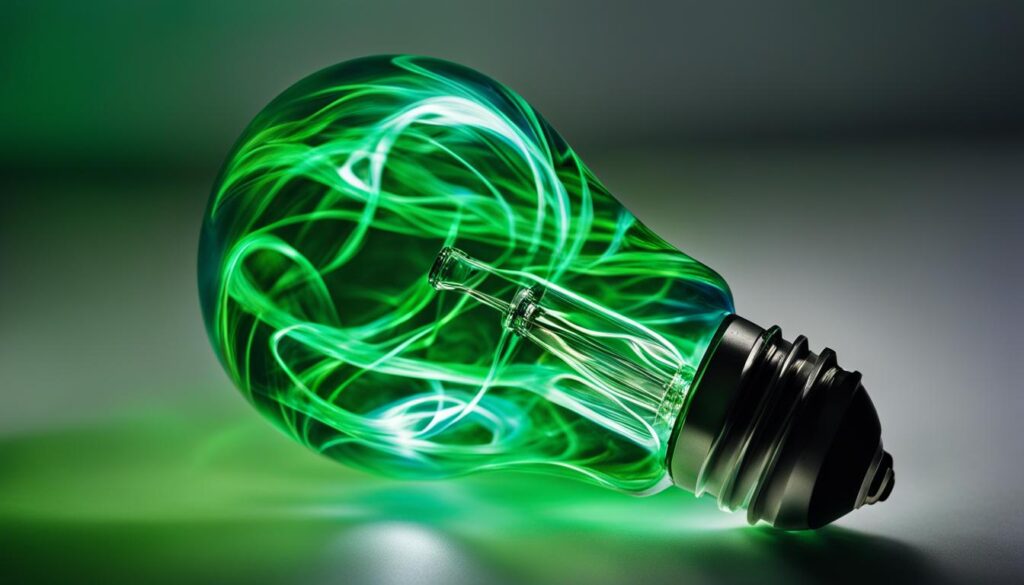
To mitigate these issues and protect our LEDs, we might consider dividing our circuits, dedicating lines to heavy-duty appliances, or installing surge protectors to manage these rapid changes in power demand. Ultimately, maintaining LEDs that flicker-free involves not just picking the right bulbs but also ensuring that they operate in a stable and well-managed electrical environment.
Selecting the Right Replacement Bulb
When our troubleshooting efforts fail to eliminate that stubborn flicker from our LED lights, it’s time we consider choosing led replacement bulbs. Upgrading to flicker-free LEDs is not only a remedy to the immediate annoyance but also a long-term investment in our lighting quality and efficiency. Let’s look at some considerations that will guide us in making well-informed decisions when selecting the perfect replacement bulb.
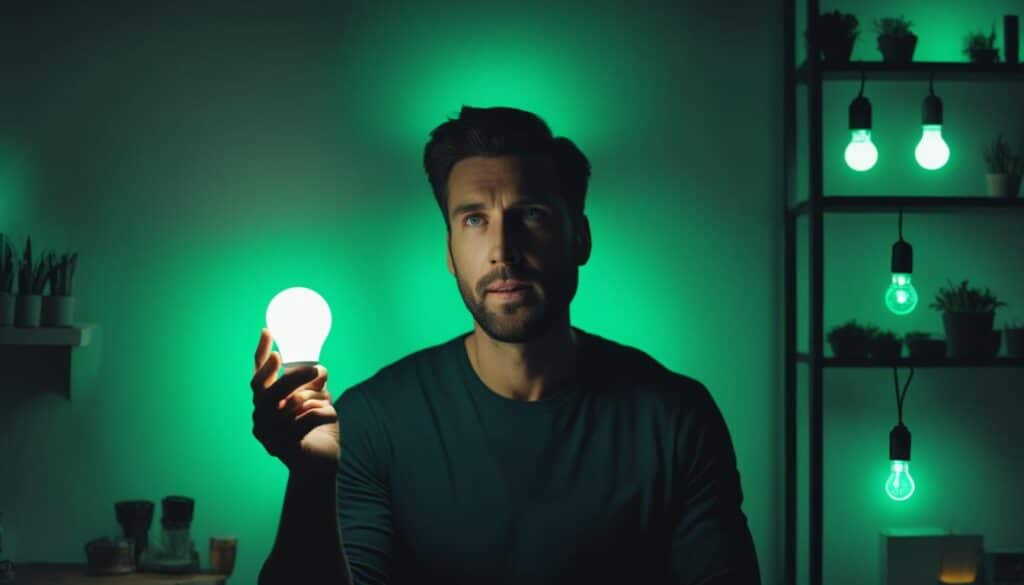
The new breed of LED T8 bulbs stands out, boasting impressive lifespans that surpass 50,000 hours and significantly improved energy efficiencies. For professional settings that depend on precision and clarity like photo studios or meticulous work spaces, choosing fixtures like flicker-free EPTA models—which promise operational times exceeding 200,000 hours—can make a significant difference.
Below is a comprehensive table comparing various LED bulb options that can assist us in upgrading to the most reliable and efficient lighting.
| LED Bulb Type | Lifespan | Energy Efficiency | Suitable Environments | Driver Quality |
|---|---|---|---|---|
| Standard LED | 25,000 hours | High | Home, Office | Varies |
| LED T8 | 50,000+ hours | Very High | Commercial, Industrial | Good to High |
| EPTA Flicker-Free | 200,000+ hours | Exceptional | Studios, Mechanic Shops | High |
| Smart LED Bulbs | 15,000 – 25,000 hours | High with added functionality | Home, Tech-Savvy Spaces | Varies |
To avoid the pitfalls of choosing poorly, we must look for LED bulbs that come with well-designed, high-quality drivers — these are the heart of the bulb’s performance and key to preventing flicker. Additionally, ensuring the compatibility of these bulbs with our current fixtures and dimmer switches will help us maintain a flicker-free existence. Through these deliberate choices, we can dramatically improve the lighting in our environments.
Professional Solutions to LED Flickering
When household remedies fail to stop LED flickering, it’s time we consider professional lighting solutions. This deep dive toward resolution starts by understanding when to consult a licensed electrician for led flickering and the importance of partnering with a respected lighting company. Bringing a professional on board can lead to the discovery of underlying issues our untrained eyes may miss, providing a permanent fix to our flickering woes.
When to Call an Electrician
Recognizing the right moment to call an electrician is crucial. Instances where LED flickering persistence despite changing bulbs and checking for loose connections is a telltale sign that a deeper electrical problem may be at play. Licensed electricians possess the tools and knowledge to meticulously evaluate circuitry and assess intricate issues such as power fluctuations or outdated wiring that could be impacting the stability of our LED lighting. When we encounter situations out of our expertise, it’s wise to reach out to a professional.
Choosing a Professional Lighting Company
Expertise in lighting is not just about swapping out bulbs; it requires a nuanced understanding of various spaces and how they’re influenced by lighting. By opting for a professional lighting company, we tap into a trove of specialized knowledge. Reputable firms like LEDVANCE provide not only premium-quality products but also personalized advice to match our specific lighting needs. Such collaborations can markedly reduce the chance of dealing with bothersome flickering in the future.

| Consideration | DIY Approach | Professional Help |
|---|---|---|
| Tools & Equipment | Limited to basic household tools | Access to professional-grade diagnostic tools |
| Expertise | Variable and often limited | Specialized electrical training and experience |
| Safety | Potential safety risks without proper knowledge | Adherence to safety codes and regulations |
| Outcome | Temporary fix or unresolved issues | Durable solutions with expert troubleshooting |
| Cost-Efficiency | Initial lower costs, with potential for greater expense from unresolved issues | Long-term savings from effective and efficient resolution |
Ultimately, addressing persistent LED flickering may require expertise beyond the household toolkit. By knowing when to call an electrician and selecting a professional lighting provider, we can ensure our environments are illuminated efficiently, safely, and flicker-free. Investing in professional lighting solutions pays off in the long run, granting us peace of mind and a superior lighting experience.
Preventive Measures to Avoid Future Flickering
Ensuring that our homes and workplaces are illuminated without the annoyance of flickering lights is a priority for us. Taking preventive steps can not only enhance the performance of LED lighting systems but also mitigate issues before they become disruptive.
Maintaining Your Electrical System
Regular maintenance of your electrical system is a cornerstone of led light bulb maintenance. This means conducting periodic checks for loosened wiring or aged components that could compromise your lighting. Not only does this safeguard against flicker, but it also promotes safety and optimizes energy efficiency.

Investing in Quality LED Products
By investing in superior led light bulbs, we invest in the longevity and reliability of our lighting solutions. Choosing LED bulbs with a track record for quality can lead to fewer replacements, consistent lighting, and long-term cost savings.
- Glance over connections semi-annually for signs of wear.
- Ensure power outlets maintain firm contact with plug prongs.
- Choose dimmers that are LED-compatible for consistent performance.
The table below outlines the benefits of quality LED light bulbs compared to standard options:
| Aspect | Quality LED Bulbs | Standard LED Bulbs |
|---|---|---|
| Lifespan | Upwards of 50,000 hours | Around 25,000 hours |
| Energy Efficiency | High efficiency with less power consumption | Lower efficiency |
| Cost Over Time | Higher initial cost but greater savings over time | Repeated replacements add up in cost |
| Light Quality | Consistent and flicker-free illumination | Potential for flickering and uneven lighting |
Conclusion
In the landscape of modern lighting, we find that flickering LED bulbs pose a nuanced challenge, one that demands meticulous attention to both fixture compatibilities and the quality of electrical installations. Our comprehensive journey through identifying and **resolving led light bulb flickering efficiently** has shown us that the pathway to **achieve flicker-free led lighting** involves a blend of practical troubleshooting and proactive upgrades. As we’ve navigated various methods—the precision of ensuring a snug bulb fit, the importance of examining your electrical system, and the wisdom in selecting premium, compatible components—we uncover the multi-faceted nature of this common yet correctable problem.
Recognize that these flickers are more than a mere annoyance; they’re a call to action for maintaining an optimal lighting environment. By prioritizing first-rate LED products and honoring the intelligence of professional consultation, we not only address existing flicker issues but also secure an infrastructure resistant to future perturbations. This is the essence of lighting care—to foresee circumstances that could disrupt our daily life and pre-emptively adapt our electronic ecosystems for enduring performance.
Let us reflect on the wisdom gleaned from these sections to fortify our approach toward sustainable luminary excellence. Our collective objective remains clear—to steadfastly pursue the highest standard of lighting, ensuring that each bulb shines with unyielding brilliance and stability. Through persistent dedication to this endeavor, we can proudly illuminate our spaces, confident in the knowledge that our LED solutions stand resilient against the flickers of uncertainty.
FAQ
Why does my LED light bulb flicker when I turn it on?
LED light bulb flickering when turned on can be due to a variety of issues such as loose connections, incompatible dimmer switches, faulty LED drivers, or voltage fluctuations typically related to low-frequency oscillations that affect the light’s performance.
What are the common causes of flickering in LED lights?
Common causes of flickering include incompatible dimmer switches, loose electrical wiring, defective LED drivers, and interruptions from other high-power devices causing power fluctuations.
How can I diagnose the flicker in my LED lights?
Begin by checking for loose connections both in the fixture and the bulb itself. If the issue persists, investigate the wiring, circuit loads, and compatibility of external devices such as dimmers. If these do not resolve the issue, the LED driver may need to be examined or replaced.
How do I fix a flickering LED light bulb?
To fix a flickering LED bulb, ensure it’s properly installed and the connections are secure. Check for loose wires, faulty dimmer switches, and consider if the LED driver may be defective. Sometimes, it may be necessary to replace the dimmer or bulb with one compatible with LED technology.
When should I replace the LED driver to stop flickering?
Replace the LED driver if it’s defective or incapable of handling voltage variations, which can lead to flickering. Using a high-quality driver that’s designed to provide a constant current can help prevent flicker.
Can dimmer switches cause LED lights to flicker?
Yes, if they are not designed to function with LEDs. LEDs require a consistent current and older dimmer switches may cause flickering by rapidly switching the circuit on and off. Using an LED-rated dimmer switch can solve this issue.
How can external power interference cause LED flickering?
High-voltage appliances can draw a large current when they start, resulting in a temporary reduction in available power. This can cause LEDs on the same circuit to flicker. Overloaded circuits, with too many devices connected, can also lead to flickering.
What should I consider when choosing a replacement LED bulb to avoid flickering?
Look for LED bulbs with quality drivers that are compatible with your current fixtures and dimmer switches. Advanced bulbs designed to minimize flickering, such as LED T8 tubes or EPTA fixtures, can provide better performance and longevity.
Who should I call for professional solutions to LED flickering?
If troubleshooting doesn’t fix the flickering, contact a licensed electrician to examine your electrical system for more complex issues. For businesses or large-scale lighting setups, consulting with a professional lighting company may offer the best solutions.
How can I prevent LED light bulbs from flickering in the future?
Prevent future flickering by maintaining your electrical system, ensuring all connections are secure, and using high-quality LED products designed for stable operation. Regular checks of power outlets and selecting the right dimmers can also help in preventing flickering issues.

